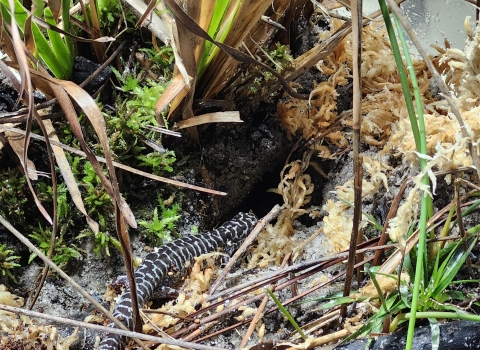The U.S. Fish and Wildlife Service (Service) is initiating a status review of two " Arizonaspecies protected under the Endangered Species Act - the endangered " Mount " Grahamred squirrel and the threatened Little Colorado spinedace.
Periodic status reviews of all listed species are required by the Act to determine if the species classification as threatened or endangered is still appropriate. The Service is seeking any new information, since the 1986 listing of the " Mount " Grahamred squirrel and the 1987 listing of the Little Colorado spinedace, from the scientific community and the public in order to conduct this review. If the best scientific and commercial data are not consistent with the current classification of either species, the Service will recommend a change in its Federal classification. A species could be recommended for reclassification from endangered to threatened (downlisting), or from threatened to endangered (uplisting), or for removal from the Federal list of endangered species (delisting). Any such changes would require a separate rule-making process and provide an opportunity for further public input.
The " Mount " Grahamred squirrel exists only as an isolated, relatively small population in the " Pinaleno " Mountainsin " Graham " County" . The quantity and quality of its habitat continues to decline due to long-term drought and destruction from insect epidemics and fire events. The " Mount " Grahamred squirrel's recovery plan is also being revised at this time.
The Little Colorado spinedace is known historically from the East Clear Creek watershed, Chevelon, Creek, and Rudd creeks, and the mainstem " Little Colorado River" . Recent surveys have been unable to locate the fish in Silver Creek, very few were found in Nutrioso and Rudd creeks, and the fish are considered rare in the East Clear Creek watershed, Chevelon Creek, and the mainstem Little Colorado River. Long-term drought and current and planned water acquisitions are limiting the amount of water available for the fish. Additionally, non-native fish and crayfish continue to compete with spinedace and prey upon them.
The Service is asking the public to provide any new information concerning the status of these species including biology, habitat, conservation measures, threats, and any other new data or information. " We are especially interested in information on the " Mount " Grahamred squirrels life history, habitat requirements, and distribution, its threats - including predation, competition, and habitat loss - and on its designated critical habitat. We specifically request information regarding the Little Colorado spinedaces current distribution and evaluation of the degree of habitat protection for each population, and information regarding management plans and techniques for improving and maintaining spinedace habitat. We also are particularly interested in recent information regarding conservation measures that have been implemented to benefit the fish.
"Scientists, land managers and the public can all assist us in this effort to evaluate the status of these two animals and their habitat," said Steve Spangle, Arizona Field Supervisor. "We want to make certain that they are properly categorized under the Endangered Species Act."
In order for new information to be considered, it should be supported by documentation such as maps, bibliographic references, methods to gather and analyze data, and copies of pertinent publications, reports, or letters by knowledgeable sources. The public will have until April 11 to provide information to be considered in this review. However, the Service welcomes new information regarding any endangered species at any time.
Information regarding the Mount Graham red squirrel and Little Colorado spinedace should be sent to the Field Supervisor, Attention 5-year Review, U.S. Fish and Wildlife Service, Arizona Ecological Services Field Office, 2321 W. Royal Palm Rd., Suite 103, Phoenix, AZ 85021, faxed to (602) 242-2513 or by e-mail to: MGRSandLCS5yr@fws.gov">."
The U.S. Fish and Wildlife Service is the principal Federal agency responsible for conserving, protecting and enhancing fish, wildlife and plants and their habitats for the continuing benefit of the American people. The Service manages the 95-million-acre National Wildlife Refuge System, which encompasses 545 national wildlife refuges, thousands of small wetlands and other special management areas. It also operates 69 national fish hatcheries, 64 fishery resources offices and 81 ecological services field stations. The agency enforces Federal wildlife laws, administers the Endangered Species Act, manages migratory bird populations, restores nationally significant fisheries, conserves and restores wildlife habitat such as wetlands, and helps foreign and Native American Tribal governments with their conservation efforts. It also oversees the Federal Assistance program, which distributes hundreds of millions of dollars in excise taxes on fishing and hunting equipment to State fish and wildlife agencies.
FWS -
" For more information about and photographs of these species, and Questions and Answers on these status reviews, visit http://www.fws.gov/arizonaes/


